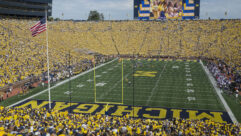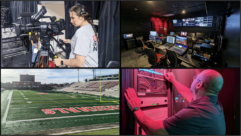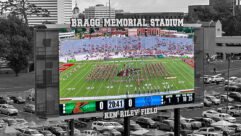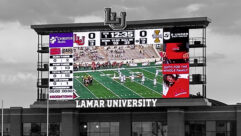
The Buzz: Installation Spotlight: University of Phoenix Stadium, Glendale, Ariz.
May 1, 2008 12:00 PM,
By Dan Daley
AV at the Bird’s Nest

At the Arizona Cardinals’ new stadium in Glendale, Michael Conner, video scoreboard operations manager, oversees the stadium’s elaborate multi-definition/multiformat broadcast control center using a Vista Systems Spyder.
When you ante up $455 million for a sports venue, you want your share of firsts even before anyone scores in a game. The Arizona Cardinals’ new stadium in Glendale succeeds on a few fronts. While many stadiums can claim retractable roofs, the Bird’s Nest, as it’s referred to (its actual name is the somewhat more prosaic University of Phoenix Stadium), also has a retractable field. That field is controlled by 13 rail tracks embedded in concrete outside the stadium, which guide an 18.9-million-pound platform the size of, well, a football field through a 4.5ft.-high flip-up slot at one end of the field using 76 1-horsepower electric motors.
VIDEO
A 96’×27′ Daktronics ProStar video screen and a 40’×22.5′ Daktronics ProAd dominate the ends of the stadium. Given Arizona’s often relentless heat, the screens were fitted with their own air-cooling systems, with conditioned air forced into the gap between the LED-bearing circuit board and the back of the display.
“Each screen has its own thermostat because, depending upon the time of day and the progression of the sun overhead, they’ll heat up at different times and to different extents,” says Michael Conner, video scoreboard operations manager, who oversees the stadium’s elaborate multi-definition/multiformat broadcast control center.
The two end-zone Daktronics displays have different aspect ratios — the north end is 16×9, but the south end is 33×9, and that’s the one that Conner can configure as needed to display a load of information in a variety of ways. “We use the Vista Systems Spyder to alter the aspect ratio depending upon what information we want to display,” he says. “We might combine a hero shot with a head shot and statistics, while the other screen is showing live action.”
Video is everywhere in the stadium, including in an air-conditioned tailgate area in the red zone. Fans can pay a fee to come in, party before the game, and watch other games on 16 LG plasma displays (eight 42in., four 52in., and four 56in.) hung throughout.
ACOUSTICAL ISSUES
Pro Sound and Video of Orlando, Fla., installed the video RF distribution system and was the design/build contractor for the stadium’s sound systems. The main PA, composed of 70 Meyer Sound Milo cabinets configured in a ring of 10 arrays, covers the main bowl and upper concourse; Meyer UPA-1P loudspeakers extend the system’s reach deeper into the stadium and concourses; and Community WET W2-2V8 loudspeakers are used for delays and fills. A Yamaha DM2000 digital console is used for FOH mixing, and it rides on a CobraNet system. DSP for the system is mainly Biamp Systems AudiaFlex and QSC Basis units.
The real challenge for the stadium’s audio, however, was acoustical. The stadium’s ownership brought in an acoustical consulting company (PMK Consultants) that presented treatment solutions arrayed in degrees, ranging from virtually no treatment at all to covering the entire interior with sprayed on or other types of deadening products. The decision was to go with a 50-percent solution, with 4in.-to-6in. fiberglass coatings placed on most of the exposed metal surfaces.
The stadium has another acoustical oddity: The combination of a retractable roof and the retractable field means that the acoustical signature will always be variable. Because the low-frequency buildup disappears when the roof is opened (the translucent Mylar material that it is made of has reflective characteristics), and the grass field is far more sonically absorptive than the concrete floor below it, that combination of systems makes for optimal sound. However, Arizona’s notorious heat means the roof of the air-conditioned facility is rarely opened — mostly later into the football season and for monster-truck rallies and other noisy events.
The PA system is flown high above the main event floor of the stadium, painted so that it becomes virtually invisible when looking up at the dome. But one of the things you will notice about the systems installation is the roomy and orderly wiring raceway that circumnavigates the stadium. “It wasn’t as easy as it looks,” says Dave Shoemaker, director of operations for Pro Sound and Video, who says that the combination of copper, Cat-5e, Cat-6, and fiber-optic cabling (which is the backbone of the audio system) required hiring a subcontractor based on sheer volume.
The Cardinals’ new stadium made its global debut when it hosted Super Bowl XLII this year, and its technology fed into Super Bowl mythology.
“Football is about being overwhelming,” Conner says. “And when you watch that roof retract and the field move in and the sound and lights and video hit their peaks, that’s what you get — overwhelmed.”
SUBSCRIBE TO SOUND & VIDEO CONTRACTOR E-NEWSLETTERS!
- Sound & Video Contractor EXTRA
Systems Integration Special Focus series:
- Houses of Worship
- Corporate AV
- Residential AV
- AV Over Fiber
- AV in Education
Breaking industry news in your email inbox every other week!
Subscribe atwww.svconline.com










